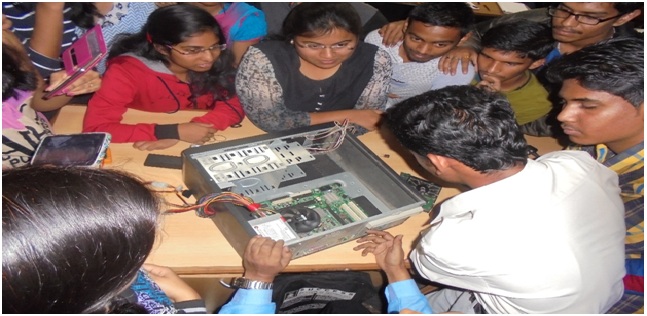The early 21st century living standards and comforts for humans (Homo sapiens sapiens) and technology-based lifestyle has become possible because of the foundations laid by breakthroughs made in Science and Technology, Innovation through Automation and Mechanization during the 20th century. However, the 22nd century is going to be shaped by Unification of Science and Convergence of Technologies – a single theory which can explain the working of planets and at the same time show how atoms and subatomic particles behave. This necessity to find single unified theory in science is enabling the convergence of Nanotechnology (material technology), Biotechnology, Information Technology and Cognitive Technology which is laying down the platform for an intelligent future world. In everyday life we can observe the technological enhancement happening in simple gadgets and devices around us. Today there are microprocessors which have 1 billion transistors which indicate that microelectronics will slowly phase out and be replaced with Nanoelectronics. 30 years ago nobody would have believed that a touch screen as thin as human hair now available in devices like mobile , tablets and other devices available in the market today would have been a possibility.
Cyborgs which we have seen only in movies are becoming a reality in laboratories through Nanobioelectronics and Neurobioelectronics because of the convergence in biotechnology and electronics at nano dimensions. There are many devices and techniques like memory resistors and brain machine interface which are being developed to replicate the functionalities of human brain. These developments have become the foundation for Cognitive Technology with rapid progress in last 10 years in the fields of Brain Science, Neuromodulation, functional Magnetic Resonance Imaging (fMRI), Robotics, Machine Learning and implantable Neuroprosthetics. Travelling into space will slowly become a normal lifestyle due to convergence in other technologies related materials (Nano, Energy), working with living cells and biomaterials (Bio), replicating the processes and decision making abilities of neurons (Cogno) and high speed, high volume data analytics through computing processors (IT).
The present crisis in environment, energy, population growth and sustainability of human species can only be solved through this convergence of technologies. It is agreed in the research communities that the IT age, will be followed by Nano age, to be followed by Cogno and finally real space age. Being a country of 1.3 billion population and still growing strong, India’s contribution to progress of modern Science and Technology in the last two centuries, is very much limited. Off late we have become a country of service engineers, doctors and managers who are dependent on developed countries for the economic growth & technology. At the same time we proudly display the gadgets and other technological marvels created in these developed countries and boast about our growth and recent IT service based success stories.
Remember, it is a globalized world, and only countries which create, discover, invent and innovate and contribute in the real sense to modern technology and scientific development are powerful and will lead from the front. That’s why today Artificial Intelligence and Machine Learning have destabilized the Indian IT service industry which was totally dependent on developed countries for VISA, projects and profit margins. Low-cost skilled laborers alone cannot sustain a country. More inventors and innovators are needed to make a country independent and developed.
In this context only contributors are remembered and revered. Einsteins, Ramans, Mendels, Faradays will be valued and their work will be studied in detail as long as the human species exists. But how many Indians are listed in any Science, or technical books or how many scientific laws are there named after Indians? Which of the gadgets that we use in our day-to-day life like mobile, television, radio, satellite, communication system, aircrafts, missiles, X-rays, MRI, were invented in India? Much of the progress that has been made in India in last 70 years has been due to the contribution of genuine researchers who are less than 10 % of the population.
The problem faced by this country could be solved only by making indigenous cost-effective technology for localized problems. And this can happen only if our education system which has become factory that produces “Literate English-Speaking Skilled Laborers” starts revamping itself towards quality research. This has to be coupled with open minds and freedom for young minds to dream and imagine. Hands-on experience with creativity ably supported with right theory and skill sets are the need of the time (as depicted in Bollywood movie 3 Idiots).
Young Indian students should take up research as a career with passion which will take this country back to its glory days 5000 years ago when Science and Technology prospered.
Author Name:
Prof.Rabinder Henry
Director
Pralhad P Chhabria Research Center (PPCRC), Pune
Prof. Rabinder. Henry is currently the Director at Pralhad P.Chhabria Research Center, Pune (A Project of Finolex). His thrust areas of work have been in transforming the education system specifically in Engineering Higher Education by making it more applied intelligence oriented. Formerly been Director for Engineering Colleges and also been CTO in the industry. He has a Master of Science Degrees in RF & Microwave Engineering (1) and Photonics (2) from Technical University Dresden and Master of Science in Medical Systems Engineering (3) form University of Magdeburg, Germany. He has worked with Fraunhofer Institute for Photonics Microsystems, Institute for Mikrosystemtechnik, Magdbeurg and Helmholtz Zentrum Rossendorf, Germany. His areas of interest include Microwave Engineering, Microfabrication, Bio implants, Photonics, Nanotechnology and convergence of technology. Professional member of many bodies IEEE, VLSI Society of India, ISTE, and ISC etc. Established Institutes at Meerut, Jaipur and Pune.
His profile has been published by Marquis Publications in Who’s Who in World 2009. Global Young Leader by UNDP (United Nations Development Program) for Peace Initiative in 2008. Awarded by Society for Reliability Engineering, Quality and Operations Management (SREQOM) for Innovative Applications of Information Technology in Interdisciplinary areas in Science and Technology, December 2009.


Recent Comments